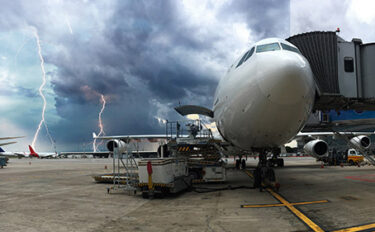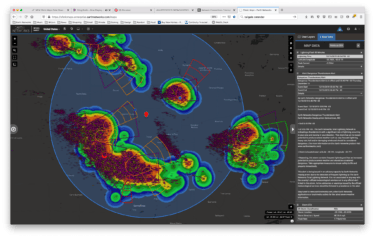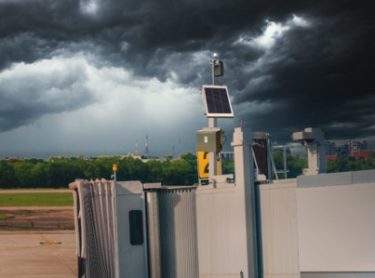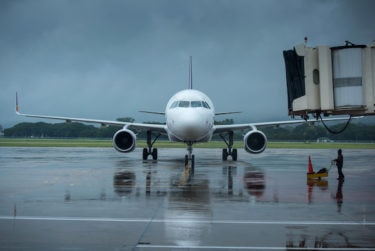Aviation
Bad weather can spell chaos for airports and airlines. Our accurate monitoring tools keep you one step ahead, and crucial ground operations running.

Bad weather can spell chaos for airports and airlines. Our accurate monitoring tools keep you one step ahead, and crucial ground operations running.


Automated alerts and all-clear signals keep ground crews safe and operations running.

Forecasts and real-time data for your exact location optimize weather risk management.

Our team of weather experts is here to provide interpretive support to customers 24/7.

SOLUTION GUIDE
Learn how our weather monitoring, lightning detection, and alarm/notification solutions help airports and airlines manage decisively and in a safety-minded manner.

Pavement condition monitoring
Weather monitoring is vital for operational continuity at airports. It enables airports to prioritize safety, manage schedules effectively, plan for major weather events, make data-driven decisions, and enhance efficiency and customer satisfaction. With a comprehensive weather monitoring system and the support of AEM’s Meteorological Services Team, airports can confidently navigate environmental challenges and maintain uninterrupted operations.
When runways become icy or covered in snow, they pose significant safety risks to aircraft operations, ground crews, and passengers. Monitoring runways for ice allows airports to promptly identify and assess hazardous conditions, enabling them to take appropriate measures to ensure the safety and well-being of everyone present. By staying vigilant and informed about runway conditions, airports can implement necessary de-icing procedures, adjust flight schedules, and communicate critical information to pilots, ensuring safe landings, take-offs, and ground operations.
Weather-responsive management, facilitated by continuous weather monitoring, enables airports to protect the safety and productivity of ground crews. By aligning operations with weather conditions, airports can optimize crew schedules, prioritize tasks, and respond efficiently to changing weather patterns. This coordination minimizes schedule disruptions, increases productivity, and maintains the operational continuity of key airport functions.

lightning detection
Deadly weather events often occur within 30 minutes of the first in-cloud flash. Our sensors improve in-cloud tracking to give you lighting alerts 50% faster than before. It’s why our data is trusted by some of the world’s leading airlines.
By leveraging advanced technology and real-time monitoring, lightning detection systems provide crucial information that helps airports and airlines make informed decisions while ensuring the safety of passengers and employees.
By detecting lightning, airports can take immediate action to protect their personnel, passengers, and aircraft. Lightning detection systems provide reliable, real-time information that enables airports to implement appropriate safety protocols, such as holding aircraft on the ground during active thunderstorms or rerouting flights to avoid areas with high lightning activity. Ultimately, this ensures the safety of everyone involved while maximizing operational continuity.

Pavement condition monitoring
Get ahead of icing events with weather tracking and alerting that let you know to start de-icing procedures. Our road sensors are NTCIP-compliant with Intelligent Transportation Systems (ITS) and offer a non-proprietary, open architecture design that allows maximum flexibility in choosing road weather sensors and telemetry options.
When runways become icy or covered in snow, they pose significant safety risks to aircraft operations, ground crews, and passengers. Monitoring runways for ice allows airports to promptly identify and assess hazardous conditions, enabling them to take appropriate measures to ensure the safety and well-being of everyone present. By staying vigilant and informed about runway conditions, airports can implement necessary de-icing procedures, adjust flight schedules, and communicate critical information to pilots, ensuring safe landings, take-offs, and ground operations.

operational efficiency
Don’t be left waiting for bad weather to arrive when you could be working. Accurate tracking helps you avoid calling your team off the tarmac too early.
Operational downtime leads to delayed flights, missed connections, and increased waiting times for passengers. By minimizing downtime, airports can improve operational efficiency, allowing for smooth transitions between aircraft arrivals and departures. This results in reduced congestion, improved turnaround times, and a more efficient use of resources, ultimately enhancing the overall airport experience for both airlines and travelers.

Make sure everyone knows lightning is on the way with our automated outdoor alert system.
Find out more
The ultimate severe weather visualization, decision support, and alerting tool, with a vast library of weather observation layers.
Find out more
In-pavement, non-intrusive, and mobile sensors track live and developing conditions on runways and roadways around the airport.
Find out more
Call on our 24/7 team of expert meteorologists to access customized real-time weather consulting and storm tracking.
Find out moreWatch how they keep crews and airplanes safe from a variety of severe weather situations.
Watch how EANA has created custom lightning alerts for specific distances around their airports.
Hear how ASCENA reduced false alarm rates by adopting Sferic Maps and forecasting within their operations.
